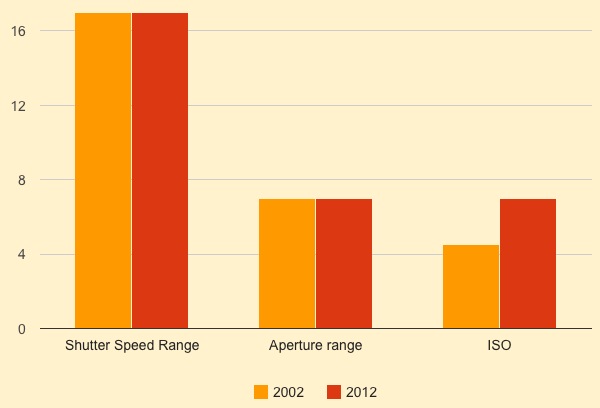We all know that the triumvirate of exposure are shutter speeds, aperture, and ISO. It's this dastardly trio that operates like security guards to photons, standing there, ear-piece in their ears, saying "Oi, if you're name's not down, you ain't coming in". The head security guard, Mr Aperture is restricting the flow of how many photons can come in at the same time. Dr Shutter Speed is opening and closing the doors to the club for various amounts of times - if he opens the door for a long time, lots of people get in. If he throws the door open and kicks it shut again, only a few people get in. Professor ISO is the allegory-wrecker who just stands there, scratching his head, wondering how the hell he fits into this whole 'club' scenario.
The ISO game-changer.
The point I was going to make, however, is that something has changed over the past ten years, and ISO has taken over power impressively quickly...
Shutter speed has remained stable; typical shutter speeds on a SLR camera range from 30 seconds to 1/4000th of a second. That's 17 stops of difference.
Apertures remain unchanged; typical aperture ranges for a standard prime lens go from f/1.8 to around f/19 or thereabouts. That's about 7 stops of difference.
However, the biggest change comes from ISO-land. Only 10 years ago, you'd be nuts to use films slower than 3200 or so (don't get me wrong, I loved my ISO 3200 T-Max... But that bad boy was grainy.). On digital cameras, ISO 1,000 was merely 'manageable' in 2002... That's only ~4.5 stops - a lot less than the range of light adjustments you get out of your ISO settings.
Compare that with the shots that are coming out of the current generation cameras. The Sony NEX-7, for example, was determined to have "quite useable results"at ISO's up to 6400, and the same verdict fell for the Nikon D3 camera:

That, ladies and gentlemen, is huge. It means that whilst the aperture and shutter speed range has essentially stood still for ten years, useful ISO ranges have increased from 1000 to 6400 - or from about 4.5 stops to 7 stops of useable range, which means that ISO now matches your aperture control when it comes to being able to control the brightness of your photos.
It might sound pretty subtle, but if you think about it, it's quite the revolution: It means that ISO, which used to be merely a fine-adjustment tool only 10 years ago, can now be used as a major component in your exposure decisions...





